Budování Dystopie je nepochybně nejvíce normativně laděná práce renomovaného britského historika architektury Jamese Stevense Curla. Předkládá komplexní dějiny architektury 20. století a přináší neidealizovaný pohled na vývoj západní architektury od roku 1918 až do současnosti. Přibližuje modernistickou revoluci a některé její devastující dopady na stavební kulturu posledních desetiletí, životní prostředí a tvář mnoha dnešních měst. Rozebírá rovněž neblahé účinky špatné architektury na psychiku lidí, kteří jsou nuceni v ní žít. Autor se kriticky věnuje i soudobé architektuře a všímá si například toho, že s každým dalším rokem je takzvaná ikonická architektura, produkovaná slavnými architektonickými celebritami, stále bizarnější, znepokojivější a dražší. Kniha svým kritickým ostřím vyvolala živou mezinárodní diskusi, která je v odborné i laické veřejnosti velmi potřebná.
James Stevens Curl Book order
Professor James Stevens Curl, Emeritus Professor of Architectural History, is a distinguished scholar whose work delves into historic buildings and their conservation. His writings are characterized by impeccable scholarship, a fine prose style, and penetrating insights that illuminate the built environment. Having transitioned to a full-time academic career in 1978, Curl had already begun establishing a reputation for his perceptive articles and books. His distinctive approach offers readers a unique lens through which to appreciate architectural history.




- 2022
- 2021
Ronnie James Dio
- 217 pages
- 8 hours of reading
Životopis heavymetalové ikony pokrývá šest dekád Diovy umělecké dráhy od úplných začátků ve školních orchestrech a následně v kapele Vegas Kings (později přejmenované na Ronnie and the Red Caps), přes angažmá v kapelách Elf, Rainbow a Black Sabbath, a rovněž Diovu sólovou dráhu, až po projekt Heaven & Hell. Součástí knihy je i kompletní Diova diskografie, dále předmluva a nekrolog, které sepsali Diovi přátelé a dlouholetí spoluhráči Jeff Pilson a Claude Schnell.
- 2006
A dictionary of architecture and landscape architecture
- 992 pages
- 35 hours of reading
Containing over 6,000 entries from alto to ziggurat , this authoritative dictionary of architecture covers all periods of Western architectural history, from ancient times to the present day. Beautifully illustrated and written in a clear and concise style, it also includes brief biographies ofleading architects, from Brunelleschi and Imhotep to Le Corbusier and Richard Rogers. The text is complimented by over 250 beautiful and meticulous line drawings, labeled cross-sections and diagrams. These include precise drawings of typical building features, making it easy for readers to identifyparticular period styles.The first edition of the Dictionary of Architecture received excellent reviews. Now it has been fully revised and expanded, bringing it completely up-to-date. New entries include definitions of landscape terms and biographies of modern architects. Each entry is followed by a mini-bibliography,with suggestions for further reading. It also contains over 50 new illustrations.This is an essential work of reference for anyone with an interest in architecture. With clear descriptions providing in-depth analysis, the second edition of A Dictionary of Architecture and Landscape Architecture is invaluable for students and professional architects, and provides afascinating wealth of information for the general reader.